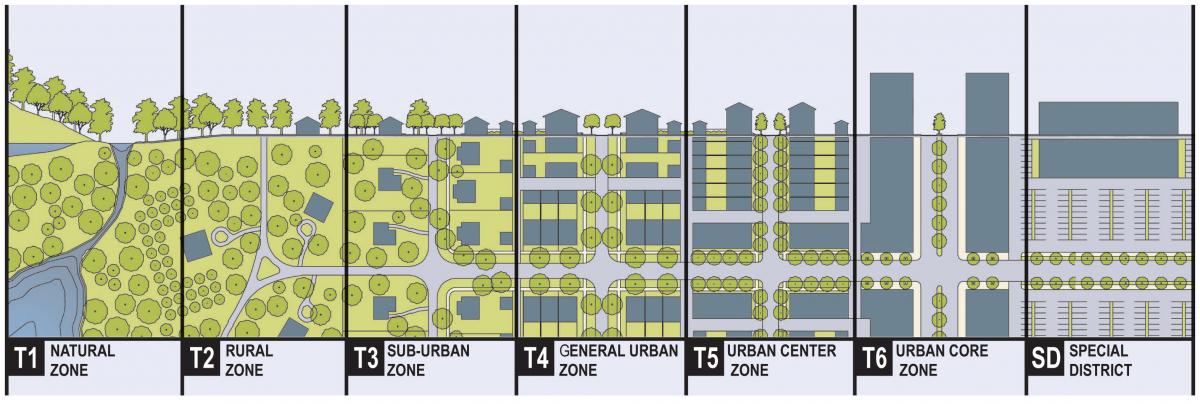The movement has a number of definitions and tools that are integral to the understanding, a few of which are explained below:
The Charrette
A charrette is an intensive planning session where citizens, designers and others collaborate on a vision for development. It provides a forum for ideas and offers the unique advantage of giving immediate feedback to the designers. More importantly, it allows everyone who participates to be a mutual author of the plan.
For more information on charrettes, visit the National Charrette Institute's website here.
The Transect

Naturalists use a concept called the transect to describe the characteristics of ecosystems and the transition from one ecosystem to another. Andres Duany has applied this concept to human settlements, and since about 2000 this idea has permeated the thinking of new urbanists. The rural-to-urban Transect is divided into six zones: core (T6), center (T5), general urban (T4), sub-urban (T3), rural (T2), and natural (T1). The remaining category, Special District, applies to parts of the built environmental with specialty uses that do not fit into neighborhoods. Examples include power plants, airports, college campuses, and big-box power centers.
The Transect is useful for designing and developing what Duany calls “immersive environments”: urban places in which the whole is greater than the sum of its parts. Duany Plater-Zyberk & Company describes the concept thus: “The Transect arranges in useful order the elements of urbanism by classifying them from rural to urban. Every urban element finds a place within its continuum. For example, a street is more urban than a road, a curb more urban than a swale, a brick wall more urban than a wooden one, and an allee of trees more urban than a cluster. Even the character of streetlights can be assigned in the Transect according to the fabrication from cast iron (most urban), extruded pipe, or wood posts (most rural).”
For more information on the transect, visit the Center for Applied Transect Studies (CATS) website here.
The Lexicon of the New Urbanism
The Lexicon of the New Urbanism is a compendium of definitions, concepts, and techniques of urban design practice. Initiated by founding members of the Congress for the New Urbanism, it provides a common vocabulary of practice and documents the empirical knowledge of the discipline.
View The Lexicon of the New Urbanism
Archive of the New Urbanism
The Archive of the New Urbanism includes drawings, project folios, books and manuscripts, periodicals, article clippings, correspondence, videos, CDs, DVDs, audio cassettes and other materials related to New Urbanism theory, writing, and design. This collection is housed in the Architecture Research Center (ARC) at the University of Miami.
View the Archive of the New Urbanism.
Codes
Form-Based Codes
A form-based code is a land development regulation that fosters predictable built results and a high-quality public realm by using physical form (rather than separation of uses) as the organizing principle for the code. A form-based code is a regulation, not a mere guideline, adopted into city, town, or county law. A form-based code offers a powerful alternative to conventional zoning regulation.
Form-based codes address the relationship between building facades and the public realm, the form and mass of buildings in relation to one another, and the scale and types of streets and blocks. The regulations and standards in form-based codes are presented in both words and clearly drawn diagrams and other visuals. They are keyed to a regulating plan that designates the appropriate form and scale (and therefore, character) of development, rather than only distinctions in land-use types.
For more information on codes, visit the Form-Based Codes Institute's website here.
SmartCode
The SmartCode is a model transect-based planning and zoning document based on environmental analysis. It addresses all scales of planning, from the region to the community to the block and building. The template is intended for local calibration to your town or neighborhood. As a form-based code, the SmartCode keeps settlements compact and rural lands open, literally reforming the sprawling patterns of separated-use zoning.
For more information on SmartCodes, visit the Center for Applied Transect Studies (CATS) website here.
*The Codes Study, a collaborative effort led by Hazel Borys and Emily Talen and contributed to by many public and private planners, tracks the prevalence of form-based codes worldwide. As of June 2019, they have tracked 728 codes that meet criteria established by the Form-Based Codes Institute (FBCI), as well as an additional 17 form-based guidelines. 439 of these are adopted, with others in progress. Even though form-based codes are 38 years old, 91% have been adopted since 2001.


















